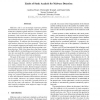58 search results - page 6 / 12 » Detection of New Malicious Code Using N-grams Signatures |
PR
2008
14 years 11 months ago
2008
Given the pervasive nature of malicious mobile code (viruses, worms, etc.), developing statistical/structural models of code execution is of considerable importance. We investigat...
ACSAC
2007
IEEE
15 years 5 months ago
2007
IEEE
Malicious code is an increasingly important problem that threatens the security of computer systems. The traditional line of defense against malware is composed of malware detecto...
104
click to vote
IEEEARES
2010
IEEE
15 years 4 months ago
2010
IEEE
Spyware represents a serious threat to confidentiality since it may result in loss of control over private data for computer users. This type of software might collect the data and...
DAC
1999
ACM
15 years 12 months ago
1999
ACM
? The economic viability of the reusable core-based design paradigm depends on the development of techniques for intellectual property protection. We introduce the first dynamic wa...
TDSC
2010
14 years 9 months ago
2010
—We propose SigFree, an online signature-free out-of-the-box application-layer method for blocking code-injection buffer overflow attack messages targeting at various Internet se...


